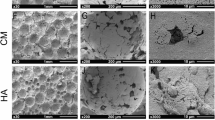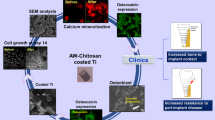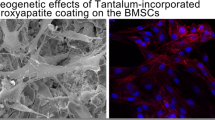Abstract
Metallic titanium (Ti) implant surfaces need improvement for bioproperties and antibacterial behavior. For this purpose, a new boron-doped bioactive apatite–wollastonite (AW) coating was successfully developed on the Ti plate surface. The effects of boron addition on the microstructure, mechanical properties, and bioproperties of the AW coating were investigated. With the addition of boron (B), the AW coating morphology became less porous and compact. In terms of bio properties, the rate of apatite formation increased with the addition of B, and the cell viability rate increased from approximately 66–81%. B addition increased the elastic modulus of the AW coating from about 24–46 GPa and increased its hardness about 2.5 times. In addition, while no antibacterial activity was observed in the AW coating, the addition of boron slightly introduced antibacterial properties. The novel AW/B composite coating obtained is promising for Ti implant surfaces.
Graphical abstract







Similar content being viewed by others
Data availability
Data will be made available on request.
References
Aufa AN, Hassan MZ, Ismail Z (2022) Recent advances in Ti–6Al–4V additively manufactured by selective laser melting for biomedical implants: prospect development. J Alloy Compd 896:163072. https://doi.org/10.1016/j.jallcom.2021.163072
Yılmaz E, Çalışkan F (2022) A new functional graded dental implant design with biocompatible and antibacterial properties. Mater Chem Phys 277:1–8. https://doi.org/10.1016/j.matchemphys.2021.125481
Moloodi A, Toraby H, Kahrobaee S et al (2021) Evaluation of fluorohydroxyapatite/strontium coating on titanium implants fabricated by hydrothermal treatment. Prog Biomater 10:185–194. https://doi.org/10.1007/s40204-021-00162-7
Seesala VS, Dhara S (2022) A novel strategy for fabricating zirconia implants with a trabecular biomimetic porous surface. J Am Ceram Soc 105:5131–5139. https://doi.org/10.1111/jace.18504
Guo Y, Chen D, Cheng M et al (2013) The bone tissue compatibility of a new Ti35Nb2Ta3Zr alloy with a low Young’s modulus. Int J Mol Med 31:689–697. https://doi.org/10.3892/ijmm.2013.1249
Si Y, Liu H, Yu H et al (2022) MOF-derived CuO@ZnO modified titanium implant for synergistic antibacterial ability, osteogenesis and angiogenesis. Colloids Surf B Biointerfaces 219:112840. https://doi.org/10.1016/j.colsurfb.2022.112840
Yılmaz E (2021) Modification of the micro arc-oxidized Ti surface for implant applications. J Bionic Eng 18:1391–1399. https://doi.org/10.1007/s42235-021-00101-z
Bargavi P, Chandran RR, Durgalakshmi D et al (2022) Drug infused Al2O3-bioactive glass coatings toward the cure of orthopedic infection. Prog Biomater 11:79–94. https://doi.org/10.1007/s40204-022-00181-y
Singh P, Bansal A, Verma VK (2022) Hydroxyapatite reinforced surface modification of SS-316L by microwave processing. Surf Interfaces 28:101701. https://doi.org/10.1016/j.surfin.2021.101701
Khvostov MV, Bulina NV, Zhukova NA et al (2022) A study on biological properties of titanium implants coated with multisubstituted hydroxyapatite. Ceram Int. https://doi.org/10.1016/j.ceramint.2022.08.067
Liu X, Ding C (2002) Morphology of apatite formed on surface of wollastonite coating soaked in simulate body fluid. Mater Lett 57:652–655
Qin W, Kolooshani A, Kolahdooz A et al (2021) Coating the magnesium implants with reinforced nanocomposite nanoparticles for use in orthopedic applications. Colloids Surf A Physicochem Eng Aspect 621:126581. https://doi.org/10.1016/j.colsurfa.2021.126581
Çalişkan F (2016) Apatite wollastonite-reinforced hydroxyapatite biocomposites. Acta Phys Polon A 129:665–668. https://doi.org/10.12693/APhysPolA.129.665
Lakshmi R, Sasikumar S (2015) Influence of needle-like morphology on the bioactivity of nanocrystalline wollastonite—an in vitro study. Int J Nanomed 10:129–136. https://doi.org/10.2147/IJN.S79986
Ming X, Ou J, Zhou D et al (2007) Preparation and properties of porous apatite-wollastonite bioactive glass-ceramic. Key Eng Mater 332:169–172. https://doi.org/10.4028/www.scientific.net/KEM.330-332.169
Tatli Z, Bretcanu O, Çalıs F, Dalgarno K (2022) Fabrication of porous apatite-wollastonite glass ceramics using a two steps sintering process. Mater Today Commun 30:1–6. https://doi.org/10.1016/j.mtcomm.2022.103216
Bao Q, Zhao K, Liu J (2012) Characterization of wollastonite coatings prepared by sol–gel on Ti substrate. J Coat Technol Res 9:189–193. https://doi.org/10.1007/s11998-009-9236-7
Liu X, Ding C, Chu PK (2004) Mechanism of apatite formation on wollastonite coatings in simulated body fluids. Biomaterials 25:1755–1761. https://doi.org/10.1016/j.biomaterials.2003.08.024
Yılmaz E, Gökçe A, Findik F, Ho G (2018) Metallurgical properties and biomimetic HA deposition performance of Ti–Nb PIM alloys. J Alloy Compd 746:301–313. https://doi.org/10.1016/j.jallcom.2018.02.274
Wei S, Ma J, Xu L et al (2020) Biodegradable materials for bone defect repair. Mil Med Res 7(54):1–25
Abd-Allah WM, Fathy RM (2022) Gamma irradiation effectuality on the antibacterial and bioactivity behavior of multicomponent borate glasses against methicillin-resistant Staphylococcus aureus (MRSA). J Biol Inorg Chem 27:155–173. https://doi.org/10.1007/s00775-021-01918-z
Hakki SS, Bozkurt BS, Hakki EE (2010) Boron regulates mineralized tissue-associated proteins in osteoblasts (MC3T3-E1). J Trace Elem Med Biol 24:243–250. https://doi.org/10.1016/j.jtemb.2010.03.003
Tunçay EÖ, Demirtaş TT, Gümüşderelioğlu M (2017) Microwave-induced production of boron-doped HAp (B-HAp) and B-HAp coated composite scaffolds. J Trace Elem Med Biol 40:72–81. https://doi.org/10.1016/j.jtemb.2016.12.005
Aksoy ME, Aksakal B, Aslan N, Dikici B (2021) Boron-doped hydroxyapatite coatings on NiTi alloys using the electrophoretic deposition method: enhanced corrosion and adhesion performances. J Mater Eng Perform 30:7365–7375. https://doi.org/10.1007/s11665-021-05968-x
Gorustovich AA, Lopez JMP, Guglielmotti MB, Cabrini RL (2006) Biological performance of boron-modified bioactive glass particles implanted in rat tibia bone marrow. Biomed Mater 100:3–9. https://doi.org/10.1088/1748-6041/1/3/002
Deilmann L, Winter O, Cerrutti B et al (2020) Effect of boron incorporation on the bioactivity, structure, and mechanical properties of ordered mesoporous bioactive glasses. J Mater Chem B 8:1456–1465. https://doi.org/10.1039/c9tb01805k
Uygulamalı S, Üniversitesi B, Fak T et al (2020) Sinterleme Yöntemiyle Apatit – Wollastonit Cam Seramik Üretimi Apatite-Wollastonite glass ceramic production by sintering method. Acad Platform J Eng Sci 8–2:217–221. https://doi.org/10.21541/apjes.656253
Catunda R, Vieira J, De OE (2017) Citotoxicity evaluation of three dental adhesives on vero cells in vitro. J Clin Exp Dent 9:4–9. https://doi.org/10.4317/jced.53039
Akshaya S, Rowlo PK, Dukle A, Nathanael AJ (2022) Antibacterial coatings for titanium implants: recent trends and future perspectives. Antibiotics 11:1–19
Crémet L, Broquet A, Asehnoune K, Dauvergne S et al (2015) Pathogenic potential of Escherichia coli clinical strains from orthopedic implant infections towards human osteoblastic cells. FEMS Pathog Dis 73:1–10. https://doi.org/10.1093/femspd/ftv065
Sharma S, Soni VP, Bellare JR (2009) Chitosan reinforced apatite–wollastonite coating by electrophoretic deposition on titanium implants. J Mater Sci Mater Med 20:1427–1436. https://doi.org/10.1007/s10856-009-3712-6
Nuswantoro NF, Budıman I, Septiawarman A et al (2019) Effect of applied voltage and coating time on nano hydroxyapatite coating on titanium alloy Ti6Al4V using electrophoretic deposition for orthopaedic implant application. IOP Conf Ser Mater Sci Eng 547:12004. https://doi.org/10.1088/1757-899X/547/1/012004
Pazarçeviren AE, Tezcaner A, Keskin D et al (2020) Boron-doped biphasic hydroxyapatite/β -tricalcium phosphate for bone tissue engineering. Biol Trace Elem Res 199:968–980
Uysal İ, Yılmaz B, Evis Z (2020) Boron doped hydroxyapatites in biomedical applications. Boron 5:199–208. https://doi.org/10.30728/boron.734804
Ramesh S, Tan C, Hamdi M et al (2007) The influence of Ca/P ratio on the properties of hydroxyapatite bioceramics. Int Soc Opt Eng. https://doi.org/10.1117/12.779890
Srinath P, Abdul Azeem P, Venugopal Reddy K (2020) Review on calcium silicate-based bioceramics in bone tissue engineering. Int J Appl Ceram Technol 17:2450–2464. https://doi.org/10.1111/ijac.13577
Chen W, Liang Y, Hou X et al (2018) Mechanical grinding preparation and characterization of TiO2-coated wollastonite composite pigments. Materials (Basel, Switzerland). https://doi.org/10.3390/ma11040593
Islam MT, Felfel RM, Abou Neel EA et al (2017) Bioactive calcium phosphate-based glasses and ceramics and their biomedical applications: a review. J Tissue Eng. https://doi.org/10.1177/2041731417719170
Liu X, Ding C, Wang Z (2012) Apatite formed on the surface of plasma-sprayed wollastonite coating immersed in simulated body fluid. Biomaterials 22:2007–2012
Chen W, Liang Y, Hou X et al (2018) Mechanical grinding preparation and characterization of TiO2-coated wollastonite composite pigments. Materials 11:1–11. https://doi.org/10.3390/ma11040593
Mondal S, Banthia AK (2020) Low-temperature synthetic route for boron carbide. J Eur Ceram Soc 25:287–291. https://doi.org/10.1016/j.jeurceramsoc.2004.08.011
Lee MH, Han MS, Kim JH (2020) A preliminary study on the roles of Fe content and neoformed Ca-rich minerals in the coloration of ceramic glazes. J Conserv Sci 36:275–283
Yılmaz E, Türk S (2022) Loading antibiotics on the surface of nano-networked sodium hydroxide treated titanium. Chem Pap 76:2459–2467. https://doi.org/10.1007/s11696-021-02045-4
Borokhov O, Schubert D (2007) Antimicrobial properties of boron derivatives. In: ACS symposium series, pp 412–435
Wang Y, Wang X, Li L et al (2022) An experimental and theoretical study on the photocatalytic antibacterial activity of boron-doped TiO2 nanoparticles. Ceram Int 48:604–614. https://doi.org/10.1016/j.ceramint.2021.09.139
Sopchenski L, Cogo S, Eli S et al (2018) Bioactive and antibacterial boron doped TiO2 coating obtained by PEO. Appl Surf Sci 458:49–58. https://doi.org/10.1016/j.apsusc.2018.07.049
Akbar W, Karagöz A, Basim GB et al (2015) Nano-boron as an antibacterial agent for functionalized textiles. Mater Res Soc Symp Proc 1793:53–57. https://doi.org/10.1557/opl.2015.728
Yılmaz E, Çakıroğlu B, Gökçe A et al (2019) Novel hydroxyapatite/graphene oxide/collagen bioactive composite coating on Ti16Nb alloys by electrodeposition. Mater Sci Eng C 101:292–305. https://doi.org/10.1016/j.msec.2019.03.078
Acknowledgements
This work was supported by the Scientific Research Projects Commission of Sakarya Applied Sciences University (Project number: 2020-29-03-018).
Author information
Authors and Affiliations
Corresponding author
Ethics declarations
Conflict of interest
The authors declare that they have no known competing financial interests or personal relationships that could have appeared to influence the work reported in this paper.
Additional information
Publisher's Note
Springer Nature remains neutral with regard to jurisdictional claims in published maps and institutional affiliations.
Supplementary Information
Below is the link to the electronic supplementary material.
Rights and permissions
Springer Nature or its licensor (e.g. a society or other partner) holds exclusive rights to this article under a publishing agreement with the author(s) or other rightsholder(s); author self-archiving of the accepted manuscript version of this article is solely governed by the terms of such publishing agreement and applicable law.
About this article
Cite this article
Yılmaz, E., Türk, S., Semerci, A.B. et al. Bioactive apatite–wollastonite glass ceramics coating on metallic titanium for biomedical applications: effect of boron. J Biol Inorg Chem 29, 75–85 (2024). https://doi.org/10.1007/s00775-023-02032-y
Received:
Accepted:
Published:
Issue Date:
DOI: https://doi.org/10.1007/s00775-023-02032-y




